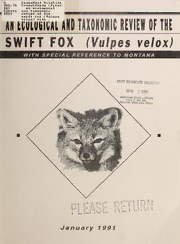
An ecological and taxonomic review of the swift fox (Vulpes velox) with special reference to Montana PDF
Preview An ecological and taxonomic review of the swift fox (Vulpes velox) with special reference to Montana
S FaunaWest Wildlife 599.74 Consultants (Firm) 442 An ecological F2etrs and taxononlc 1991 review of the swift fox Vulpes ( veloxi with AN tl'ULUWAL REVIEW OF THE SWIFT FOX (Vulpes velox) WITH SPECIAL REFERENCE TO MONTANA January 1991 MONTANASTATELIBRARY AM S599.74442F2etrs1991C.1 Anecologicalandtaxonomicreviewofth ft 3 0864 00072197 2 2 2004 AN ECOLOGICAL AND TAXONOMIC REVIEW OF THE SWIFT FOX Vulpes velox) ( WITH SPECIAL REFERENCE TO MONTANA prepared by FaunaWest Wildlife Consultants P.O. Box 113 Boulder, MT 59632 (406) 225-3221 prepared for Montana Department Fish, Wildlife and Parks Montana State University Campus Bozeman, MT 59717 8 January 1991 TABLE OF CONTENTS SECTION PAGE LIST OF FIGURES ii INTRODUCTION 1 DISTRIBUTION AND STATUS 1 TAXONOMY 17 SPECIES DESCRIPTION 18 REPRODUCTION 21 DENS 21 POPULATION STRUCTURE 22 MORTALITY 23 HABITAT USE 23 HOME RANGE AND DISPERSAL 25 FOOD HABITS 25 BEHAVIOR 27 MANAGEMENT AND ECONOMIC VALUE 27 PARASITES AND DISEASES 28 PREDATION 30 SURVEY TECHNIQUES 30 REINTRODUCTION 33 POTENTIAL MONTANA REINTRODUCTION SITES 36 RECOMMENDATIONS 38 ACKNOWLEDGMENTS 40 LITERATURE CITED 41 APPENDIX A 50 i LIST OF FIGURES Figure 1. Historic range of the swift and kit foxes 2 Figure 2. Probable present range of the swift fox 4 Figure 3. Present range of the red fox 5 Figure 4. Present range of the gray wolf 6 Figure 5. Present range of the coyote 7 Figure 6. Historic and present records of swift foxes in Montana 10 Figure 7. Recent records (X) of the swift fox in North Dakota 11 Figure 8. Established populations (P) and recent records (X) of the swift fox in South Dakota 13 Figure 9. Current range of the swift fox in Wyoming 14 Figure 10. General release sites of swift foxes in Alberta and Saskatchewan 15 Figure 11. Lateral, ventral, and dorsal views of a swift fox skull showing condylobasal measurement of 105-120 mm. (Modified from Egoscue (1979)) 19 Figure 12. Physical characteristics of the swift fox 2 Figure 13. Tracks, trail, and scat of the swift fox. (Modified from Murie (1975)) 32 li Digitized by the Internet Archive 2013 in http://archive.org/details/ecologicaltaxono1991faun . , INTRODUCTION The swift fox Vulpes velox) and its close relative, the kit ( fox (V. macrotis represent the smallest North American members of ) , the family Canidae Weighing from 4 to 6 pounds and measuring just . over 2 feet, the swift fox is a uniform buffy tan except for a black-tipped tail and dark patches on either side of its nose. The swift fox is a predator of small mammals, birds, and insects. The swift fox is believed to have originally been abundant throughout its range on the Great Plains. It was extirpated early in this century from the northern portion of its range while remnant populations in the southern portion survived human settlement of the prairies. The original cause of this widespread extirpation is attributed to the ready acceptance of poisoned baits and traps placed for coyote Canis latrans and wolf (Canis lupus ( ) ) extermination. Loss of habitat to dry land agriculture, a changing prey base, and increased interspecific competition from coyotes and red foxes (V. vulpes may have also contributed to this decline. ) The loss of the swift fox over such a broad area prior to the advent of quantitative ecological studies has resulted in a paucity of ecological information on this species. Virtually nothing is known about this species in Montana. Its small size and nocturnal habits have also contributed to this lack of even basic biological information. In recent years, swift foxes have increased in numbers and records of dispersing swift foxes have been reported in formerly unoccupied areas. As a result, there has been increased interest by state and provincial conservation agencies with regard to swift fox ecology and conservation. The purpose of this paper is to review published information on the distribution, taxonomy, biology, ecological relationships, and food habits of the swift fox. Conservation issues and swift fox reintroduction programs are also reviewed. Special effort has been placed on reconstructing the original distribution of the swift fox in Montana, its prey base, and habitat use. This paper is designed to provide baseline biological information on the swift fox to aid in designing a cost effective and biologically sound swift fox reintroduction/management program for the state of Montana DISTRIBUTION AND STATUS The swift fox originally occurred throughout the Great Plains from the southern portion of the Canadian prairie provinces south to central Texas (Figure 1) (Hall 1981) . The swift fox ranged as far east as western Iowa and Minnesota, although there are no specimen records for verification (Allen 1870, Swanson et al. 1945, Bowles 1975) The Rocky Mountains represent the western margin of . 1 Figure 1. Historic range of the swift and kit foxes. 2
